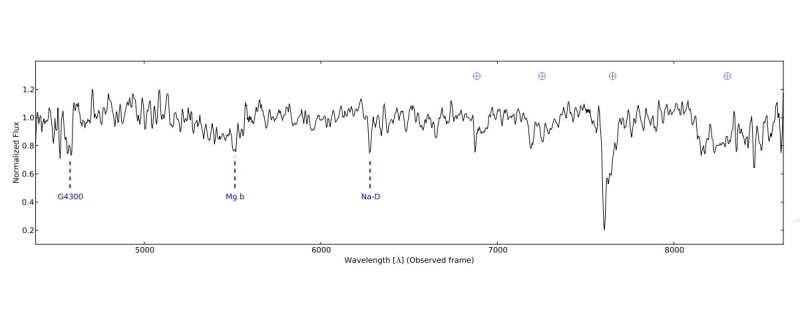May 4, 2020 report
Research investigates extreme blazar 2WHSP J073326.7+515354

Tomasz Nowakowski
astronomy writer

In a new study published April 23 on arXiv.org, Spanish astronomers have reported on an extreme blazar known as 2WHSP J073326.7+515354. Results of the research reveal the distance to this source and provide essential information about the stellar population of its host galaxy.
Blazars are very compact quasars associated with supermassive black holes at the centers of active, giant elliptical galaxies. Based on their optical emission properties, astronomers divide blazars into two classes: flat-spectrum radio quasars (FSRQs) that feature broad, prominent optical emission lines, and BL Lacertae objects (BL Lacs), which do not.
One subclass of BL Lacs with the highest frequency of synchrotron peak (over 100 PHz) comprises extreme high-frequency peaked BL Lacs (EHBLs). 2WHSP J073326.7+515354 (also called PGC 2402248) is a gamma-ray emitter first reported in 2017, and one of the few EHBLs detected at TeV energies. Therefore, the object is of particular interest for astronomers studying very high energy (VHE) blazars.
A team of researchers led by Josefa Becerra Gonzalez of the University of La Laguna, Spain, have recently observed 2WHSP J073326.7+515354 using the 10.4-meter Gran Telescopio de Canarias (GTC) and the 2.5-meter Isaac Newton Telescope (INT). The observations allowed them to determine the blazar's redshift precisely and provided more hints about the properties of its host.
"In this work we performed the first optical characterization of 2WHSP J073326.7+515354 using optical spectroscopic observations with INT and GTC telescopes," the paper reads.
The observations confirmed that like in many EHBLs, the optical spectrum of 2WHSP J073326.7+515354 is dominated by its host galaxy emission. In general, the bulk of the relativistic jets emission in EHBLs is at higher energies, which allows astronomers to better observe the optical emission from the host galaxy.
The researchers found that 2WHSP J073326.7+515354 is at a redshift of approximately 0.0065. This is the first distance estimation for this source, and knowing the exact redshift could be important for gamma-ray studies. It could, for instance, be helpful to estimate the effect of the distortion imprinted by the interaction of gamma-rays with the extragalactic background light (EBL).
Furthermore, the study provided crucial information about the properties of the investigated blazar's host. The researchers found that it is an elliptical galaxy with an old stellar population. It has a nuclear region and a classical extended bulge. The astronomers estimated that the mean stellar age of this galaxy is about 11.72 billion years, and its mean metallicity is approximately 0.159.
In addition, the astronomers calculated the mass of the host galaxy's black hole using two methods that yielded two comparable results. According to one method, the black hole has a mass of around 370 million solar masses, while the other one points to a larger mass of some 480 million solar masses.
Written for you by our author —this article is the result of careful human work. We rely on readers like you to keep independent science journalism alive. If this reporting matters to you, please consider a (especially monthly). You'll get an ad-free account as a thank-you.
More information: Optical spectral characterization of the the TeV extreme blazar 2WHSP J073326.7+515354, arXiv:2004.11359 [astro-ph.GA]
© 2020 Science X Network





















